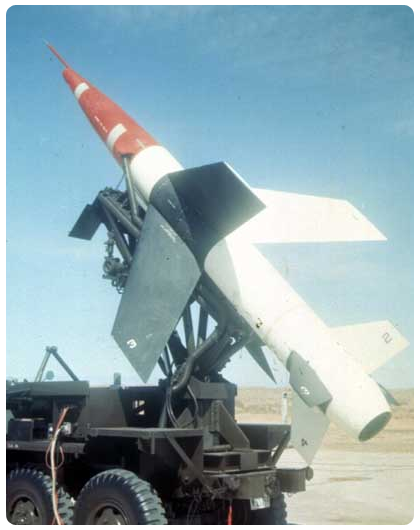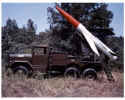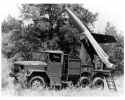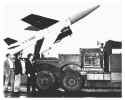The LACROSSE guided missile was a surface-to-surface weapon designed for close tactical support of ground troops. It was an all-weather system capable of carrying nuclear and high-explosive warheads which could destroy hard point targets. First deployed in 1959, the LACROSSE was declared obsolete in 1964.
View more LACROSSE photos

System Chronology
|
15 September 47 The LACROSSE project began with a Marine Corps (USMC) requirement for a guided missile to supplement conventional artillery in close support of ground troops. Project LACROSSE was established at the Applied Physics Laboratory (APL) of the John Hopkins University (JHU). The Cornell Aeronautical Laboratory, Inc., studied guidance accuracy for the system. Both the APL/JHU and Cornell investigated the weapon under contracts awarded by the Navy Bureau of Ordnance. June 49 Cornell was assigned the task of selecting a guided missile system suitable for development and conforming to LACROSSE specifications. Late 1949 The Joint Chiefs of Staff established a new policy governing the development and use of guided missiles. Under the new policy, Army Ordnance was assigned responsibility for antiaircraft guided missiles and for ground-launched, short range, surface-to-surface guided missiles supporting or extending conventional artillery capabilities. The LACROSSE program fell under the latter category. March 50 The Joint Chiefs of Staff recommended that the LACROSSE project be transferred from the Navy to DA. July 50 Responding to the impetus of the Korean War, Army Ordnance started an interim LACROSSE program at Cornell, 1 month before the formal transfer of the project from the Navy to DA was accomplished. 31 August 50 Secretary of Defense transferred the LACROSSE Project to Army Ordnance in accordance with the 1949 Joint Chiefs of Staff policy governing guided missile development and use by the armed services. The project was assigned a DA priority of lB; the LACROSSE research and development program proceeded under this priority until mid-1952. Early 1951 The USMC Project Officer for LACROSSE at OCO developed a paper with the USMC's and contemplated Army requirements for the weapon system. This paper incorporated significant changes from the original 1947 requirements. February 51 Army Ordnance awarded Cornell a formal development contract for the LACROSSE. 31 July 52 Ordnance Technology Committee assigned a lA priority to the LACROSSE project. January 53 Development of the LACROSSE had progressed to the point where major elements of the weapon system were defined and it was possible to formulate definite Ordnance Corps development instructions. Revised instructions for the project stipulated for the first time that a solid propellant rocket motor would be used. Early 1954 Cornell started work on the tactical LACROSSE I system. By the time a co-contractor was named, Cornell had essentially completed the design of the tactical model and successfully demonstrated system feasibility. 11 January 54 OCO technical control and supervision of the LACROSSE project was delegated to Redstone Arsenal. 17 August 54 - 13 December 55 The first full-scale testing of the LACROSSE was conducted at White Sands Missile Range, with 15 Group A missiles flown. January 55 The Glenn L. Martin Company was approved as the LACROSSE research and development co-contractor. 1 April 55 Ordnance awarded the Glenn L. Martin Company a co-contract for research and development. 1 June 55 Martin received the initial production contract for the LACROSSE. 1956 Transfer of technical responsibility from Cornell to Martin was started. Cornell's effort on the system was reoriented on research and development to improve and extend the weapon's capabilities. Early 1956 A radically different guidance system designed to decrease the LACROSSE's vulnerability to enemy countermeasures and detection, known as the MOD I, was selected for development to provide an electronic counter-countermeasure (ECCM) capability for the LACROSSE. 19 January 56 The first formal statement of military characteristics for the LACROSSE were approved and published. March 56 The Federal Telecommunications Laboratory began development of the MOD I system under a subcontract with Martin. 10 March 56 ADA directive placed the LACROSSE warheads in order of priority: atomic, controlled fragmentation, and shaped charge. 29 March 56 - 21 September 56 Group B flight tests, consisting of six firings, were conducted at White Sands Missile Range. June 56 The first LACROSSE I production prototype missile was delivered. 13 June 57 Revised military characteristics reflecting the expanded tactical mission of the LACROSSE system were approved and published. January 58 A second contract was awarded to Cornell. It ran concurrently with the basic contract issued in February 51 until December 58, when the basic contract was terminated. Supplemental efforts conducted under the basic contract were continued under the second contract. March 58 Federal Telecommunications Laboratory delivered the first de sign of the MOD I components, which were known as Series 100 equipment. 19 March 58 Transfer of technical responsibility from Cornell to Martin was completed. 19 March 58 Task IV evaluation firings began at White Sands Missile Range. These tests, which were the sole responsibility of Martin, involved the final tactical stage of the LACROSSE development program and the missiles used were the ultimate tactical configuration for the system. However, these firings showed that the functional reliability of the missile components had not been maintained. 1 April 58 Redstone Arsenal responsibilities in the LACROSSE program were transferred to the U.S. Army Rocket & Guided Missile Agency (ARGMA). 28 November 58 LACROSSE I service tests were suspended because of system deficiencies. The production of LACROSSE I items was also suspended so that a series of special tests could be conducted. 28 November-12 December 58 Operation Pickle Barrel , a special firing program to determine and establish fixes for existing LACROSSE deficiencies, was conducted. 19 January 59 Because of testing problems, the LACROSSE schedule was reoriented. The Ordnance Readiness Date was delayed from April to July 59. 1 July 59 LACROSSE equipment for the first reduced-strength Artillery battalion and its Ordnance Support Detachment was delivered to Fort Sill, Oklahoma, thereby achieving the rescheduled Ordnance Readiness Date. The system delivered was basically acceptable but not fully reliable or perfected. 18 August 59 The MOD I effort was terminated as a result of a funding shortage. This left the LACROSSE vulnerable to simple radio interference and enemy countermeasures and detection. As a result, the USMC withdrew from the program. March 60 The first LACROSSE battalion was deployed to Europe. April 60 The first LACROSSE battalion was deployed in Korea. October 60 The LACROSSE was subjected to a "kill or cure" exercise which left the program in a reduced-strength, buy-out, terminal status by 4 January 61. 17 July 63 The LACROSSE Commodity Office, which had operated under the PERSHING PM, was disbanded. Management functions for the system were transferred to the Directorate of Supply and Maintenance. February 64 The LACROSSE was type classified as obsolete. |
LACROSSE Photos





|
